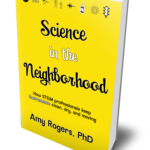Are silent COVID-19 infections vastly more numerous than we thought?

Bearded irises from my garden
Today is Easter Sunday, April 12, 2020. Easter is a day of hope, so I am going to talk about a hopeful possibility. It’s only a possibility, not a fully fact-based assertion. But if it is true, we might have an easier way out of this disaster than I currently expect. The hope: maybe COVID-19 is more like seasonal flu than initial data indicate. That it’s like seasonal flu compressed into a tight timeframe, yielding a New York-style spike in cases, with a hope for quiet after. Let me explain.
One indisputable fact we’ve learned about SARS-CoV-2, the virus which causes COVID-19, is that the virus is quite contagious. Epidemiologists quantify this with a number called the basic reproduction number, or R0 (R-naught). R0 is the number of other people infected by one person carrying the virus. According to a recent Economist article, best current guess for this number for the coronavirus is 3.9, meaning that in a population where no one is immune, and no precautions are taken to control the outbreak, each infected individual passes on the virus to nearly four other people. The goal of social distancing, of course, is to decrease that number. When the number drops below 1, the outbreak fades away.
Another truth we’ve learned is that it is possible to be infected, not be sick, and yet infect other people. The scope of asymptomatic infection is unknown. Testing for coronavirus infection has been limited and insufficient in almost every country. Testing preference has been given to people with symptoms.
Combine a highly infectious virus, asymptomatic infection, and minimal testing. What do you get? A big question. How many people out there have “recovered” from coronavirus infection, and not even know it? These lucky folks could be hugely important for the future of the pandemic, because presumably they are either immune to re-infection, or at least significantly protected by their immune system’s memory. They could be the key to stopping the pandemic and restarting the economy.
Once enough people in a population become immune, either through natural infection or vaccination, the virus can no longer find a new host, and R0 goes toward zero. This is called herd immunity.
The hope I spoke of is the hope that asymptomatic infection by SARS-CoV-2 is far more common than we have measured so far. That maybe vast numbers of people out there have already conquered the infection silently, and will serve as a fire break against contagion in the future.
Is there any data to support this? Some.
1. On the USS Theodore Roosevelt, comprehensive testing of the crew shows almost 10% of them were infected. More than half of those testing positive had no symptoms. (CNN)
2. Reporting on a new statistical analysis from the Imperial College COVID team, the Economist says:
“The results suggest the virus is far more prevalent than official case counts would suggest. Across the 11 European countries studied, official government statistics indicate that there are 319,500 confirmed cases, affecting less than 0.1% of the population. The Imperial researchers peg the more likely figure at 18.5m cases (with a confidence interval of between 7m and 43m), which suggests that, as of March 28th, 5% of the population in these countries have contracted the virus.”
If the statisticians are right, it means the case fatality rate for COVID-19 is lower than what the official numbers (based on diagnostic testing) tell us.
3. Finally, this report from The Economist, in reference to this pre-print scientific publication, is the most tantalizing. Because coronavirus testing has been so sparse, investigators are using proxies to detect SARS-CoV-2 infection. In the US, one of the ongoing epidemiology tasks of the Centers for Disease Control is flu surveillance. Every week, they collect data from clinicians who report the share of their patients who have an “influenza-like illness” (ILI)—a fever of at least 37.8°C (100°F) and a cough or sore throat, without a known non-flu reason. Obviously some of those cases are caused by influenza virus, and there are multiple other causes too. These days, one of those causes is SARS-CoV-2.
Here’s where it gets interesting. According to the CDC outpatient data, in the last month, non-flu influenza-like illnesses have surged. And the breakdown by state correlates with diagnosed COVID-19 cases, suggesting that a significant number of those undiagnosed illnesses are coronavirus infections. The Economist says,
“In total, estimated non-flu influenza-like illnesses from March 8th to 28th exceeded a historical baseline by 23 million cases—200 times the number of positive COVID-19 tests in that period.”
Using January 15 as a start date for community transmission in the US, the paper’s authors calculate that the epidemic doubled about every 3 days.
“The surge in ILI and analysis of doubling times suggest that SARS-CoV-2 has spread rapidly throughout the US and is likely accompanied by a large undiagnosed population of potential COVID outpatients with presumably milder clinical symptoms than would be thought based on prior studies of SARS-CoV-2+ inpatients.”
“Together this suggests that the true prevalence of SARS-CoV-2 within the US is much larger than currently appreciated and that even the highest symptomatic case detection rates are likely lower than 3%.”
Bingo. If this analysis is correct, then the actual fatality rate of COVID-19 is somewhere around 0.1%–comparable to seasonal flu. And a lot of people out there may already be immune.
Which leads to The Economist’s final point:
“Perhaps New York’s hospitals are overflowing because the virus is so contagious that it has crammed the equivalent of a year’s worth of flu cases into one week.”
There are several reasons why this interpretation of CDC flu surveillance data might be wrong; see the paper for details. And although I’m spinning this possibility as good news, of course that is relative to other possible scenarios. It’s not a “good” thing to expect a hundred thousand US deaths from an emerging virus. But it’s a lot better than several hundreds of thousands, or millions.
So my Easter hope for the coronavirus pandemic is that the virus has, or will, swiftly sweep through swaths of humanity but leave huge numbers unscathed, trailing herd immunity in its wake.
Amy Rogers, MD, PhD, is a scientist, novelist, journalist, and educator. Learn more about Amy’s science thriller novels, or download a free ebook on the scientific backstory of SARS-CoV-2 and emerging infections, at AmyRogers.com.
 Do you like my science journalism? Read Science in the Neighborhood and learn, where does my tap water come from? How are mosquitoes managed? What happens after I flush? Where does my electricity come from?
Do you like my science journalism? Read Science in the Neighborhood and learn, where does my tap water come from? How are mosquitoes managed? What happens after I flush? Where does my electricity come from?
0 Comments
Share this:



0 Comments